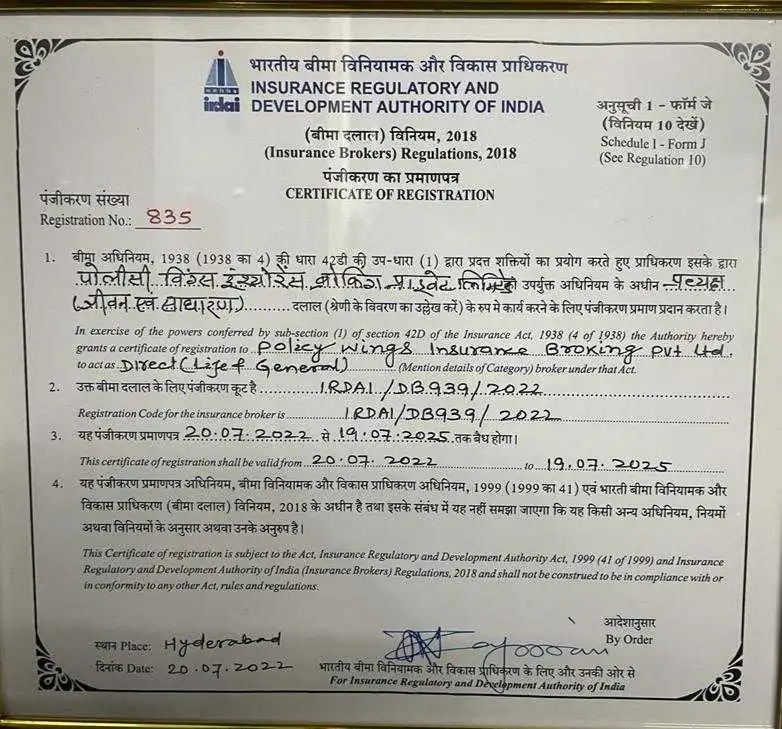Sum Insured V/S Sum Assured
Easy Navigation
Sum Insured vs Sum Assured
Maintaining health and life insurance policies has become critical in the contemporary financial scenario. Although these have become indispensable, the technical jargon of the insurance sector still overwhelms us. But to ensure enjoying the complete benefits of the policies, it is quite crucial to understand these terminologies well.
Difference Between the Sum Insured and Sum Assured
Two of the most significant and confusing insurance terminologies include the sum insured and the sum assured. Although these two terms seem to be the same, they are drastically different from each other. The former is applicable exclusively for health insurance and other general insurance policies, while the latter is applicable for life insurance. The utilities of these sums also hugely differ from each other.
The sum assured is the pre-fixed amount mutually agreed between both the insurer and the insured during the purchase of the plan. It denotes the amount that the policyholder is liable to receive from the insurance company once the concerned plan completes its term; or if the policyholder passes away during the policy term, his/her beneficiaries will receive this amount. Thus, the concept of Sum Assured is an exclusive concept of Life Insurance only and has no relevance in General Insurance Plans.
On the other hand, the Sum Insured is the optimum extent up to which the health/home/motor insurance company will bear the costs incurred by the policyholder, excluding the deductibles. If the total bill exceeds this pre-determined amount, the policyholder needs to bear the excess amount. Thus, the Sum Insured is the maximum amount of coverage the insurer would pay based on the clauses of indemnity. However, one can opt for multiple general insurance plans as well, where the total amount of claim payable, across all insurers together, should not exceed the total financial loss borne by the insured.
Sum Insured V/S Sum Assured: The Basic Difference in Concept and its Applicability
It is essential to clearly understand the difference between these two very common insurance terminologies to avoid misunderstandings during claim settlement. It will aid you in selecting the correct amount depending on the terms and conditions of the concerned plan.
So, in order for you to opt for the best life insurance coverage for yourself, you need to choose the Sum Assured according to a certain multiple based on your income, lifestyle, financial dependents, etc.
However, for you to ensure that you get the best in class healthcare treatment without having to worry about the financial aspects of the same, you should opt for a high Sum Insured so that your hospitalisation expenses are taken care of.
What is the Sum Insured? The Meaning
The amount of sum insured in any insurance plan is determined by the indemnity principle, which offers coverage or compensation against any injury, loss, or damage. This generally applies to non-life insurance products like home insurance, motor insurance, or health insurance. These plans simply reimburse the damages, losses, or costs incurred by the insured individual.
The premiums you pay for such plans depend on the value of the sum insured. The higher the amount, the higher the premium. The premiums that you pay towards health insurance are eligible for tax deduction under Section 80D of the IT Act.
For instance, if you possess a health plan worth a sum insured amount of INR 1 lakh. If with hospitalisation, your bill amounts to INR 50000, your health insurance provider is liable for reimbursing the entire amount, excluding the deductibles if applicable. However, if the hospital bill amounts to INR 2 lakhs, the insurance provider will bear costs only up to INR 1 lakh. You have to settle the remaining amount out of your pocket.
The principal target of the base amount of the sum insured is to get sufficient compensation for the losses or expenses incurred, providing no other sort of financial benefit.
How is the Sum Insured Calculated?
While calculating the basic amount of sum insured for the insurance plan you have selected, you need to consider certain crucial factors, including:
1. If you seek to insure any valuable asset, you need to accurately assess the cost of the concerned asset, to ensure complete coverage and compensation for any unfortunate loss or damage
2. With a health insurance plan, it is essential to go for a higher amount of sum insured to ensure sufficient coverage to secure the health of yourself and your family members with any medical contingency
3. With a family floater insurance policy, you must be wise enough to decide on sufficient coverage for all the members included in the plan
4. If you seek to insure your personal life, consider your current financial status, income, assets, liabilities, and other financial targets and plans
5. While considering the value of the sum insured, never fail to consider the effect of inflation, especially in the long term
6. Consider your current income and financial status, and opt for a befitting amount of the sum insured which is not too burdensome on your pocket
Can You Enhance the Sum Insured?
Yes, there are multiple methods where you can enhance your amount of sum insured if you find it to be insufficient:
1. During plan renewal:
While you are renewing your existing health insurance policy, intimate your respective insurance provider to enhance the amount of the sum insured for the new term of your insurance. However, you have to remember here that it will slightly your premium payability amount too.
2. Using cumulative bonus:
Several insurance providers enhance the sum insured amount to a certain extent for raising no claims during a policy term.
3. Getting a top-up plan:
You can also choose to purchase a top-up or a super top-up plan from your chosen insurer to enhance your overall coverage span.
Role of Sum Insured in General Insurance:
The sum insured amount also applies in the context of general insurance. Here it refers to the optimum limit till which you are eligible to raise claims for covering the medical treatment costs considering the terms of the concerned plan.
You can use a part of it and claim the remaining balance for the following claim until the policy expires or exhausts, whichever happens earlier.
You can utilise the amount of sum insured for yourself as well as for other members of your family, provided it follows the terms and conditions of the concerned plan.
For family floater plans, this amount is flexible, implying that all the covered members possess equal access to the amount of sum insured and does not remain constant for any single member.
Opting for the Right Sum Insured for Your Health Insurance Policy:
You must select the right amount of sum insured for your plan. For instance, if you buy a health plan that covers several ailments. But you develop a health condition that requires a considerable fund for treatment.
You raise the claim, only to discover that the claim amount is higher than the insurer’s payout limit. You have to settle the excess dues out of your pocket, and that may prove to be burdensome for you. This may deplete a significant portion of your savings.
Purchasing a health plan was right. But you weren’t careful about selecting the sufficient sum insured amount that resulted in such financial drainage.
To avoid such unfavourable circumstances, it is crucial to choose the correct sum insured amount.
Importance of Opting for the Right Amount of Sum Insured:
Choosing the correct sum insured amount is highly essential for the following reasons:
1. A lower amount of the sum insured signifies a lower premium amount which you will have to pay later. Therefore, a comparatively higher sum insured margin will enhance your medical emergency fund
2. A sufficient amount of the sum insured will aid in protecting your savings
3. Ensuring proper financial protection against medical contingencies retains your peace of mind
4. In the case of the family floater plan, it is essential to maintain a high amount of sum insured. As all the family members share the sum insured amount, a lower amount may prove to be insufficient, especially if there are multiple claims in one year. A higher sum insured amount ensures sufficient coverage.
Factors Responsible for Determining the Amount of Sum Insured:
Some prominent factors that determine the actual amount of sum insured are as follows:
1. Life stage and age:
Your family responsibilities remain low while you are still young. It increases with age when you marry, expand your family and so on. Your necessity for a higher amount of sum insured increases with age.
2. Number of dependents:
When your total number of dependents is high, it is better to opt for a higher sum insured amount to ensure sufficient coverage for all.
3. Health status:
In case you possess any health condition or have a hereditary medical history of any particular ailment, you must consider choosing a comparatively higher sum insured amount.
4. Lifestyle:
If you lead a fast life with little or no time for exercise, you risk falling ill more often. A higher sum insured ensures better coverage protection for frequent claims.
Understanding Sum Assured- The Basic Meaning:
The sum assured denotes the amount in a life insurance plan, that is pre-determined and mutually agreed upon by both the insurer and the insured during the time of policy purchase. It is the amount that the insurance provider is liable to pay to the policyholder at the end of the policy term. Unfortunately, if the policyholder passes away during the policy term, this amount is received by the legal beneficiaries of the concerned policyholder.
The amount of sum assured remains constant throughout the policy tenure. The premium value of the insurance plan depends on the amount of the sum assured decided. Once the insurance provider pays the amount to the policyholder or his/her beneficiaries, the insurance plan gets automatically terminated and ceases to exist.
This concept is especially applicable to life insurance plans, securing your life as a policyholder as well as your near and dear dependents in the case of your absence.
A life insurance plan with guaranteed returns can be payable in a specific mode according to your convenience. You can opt for a lump sum payout or payouts at regular pre-fixed installments.
The premium payout can also be paid according to your choice, either annually, half-yearly, monthly, or quarterly, You can even avail of a loan facility against your existing life insurance policy. Moreover, you must also note that guaranteed insurance policies in India enjoy tax benefits.
The premiums that you pay towards these insurance policies are eligible for tax exemption under Section 80C of the IT Act. The maturity proceeds and the death benefit enjoys tax benefits under Section 10(10D) of the Indian Income Tax Act.
You can possess a guaranteed return life insurance plan maintaining a sum assured amount of INR 15 lakhs, on the completion of the plan or during your untimely and unfortunate demise during the plan term. This implies that your legal nominee will receive this sum on your untimely demise during the policy tenure.
How is the Sum Assured Calculated?
Selecting the correct amount of sum assured proves to be critically essential as it possesses the possibility to secure your future along with your near and dear family members despite your absence. To determine this value critically, you have to wisely consider these factors for determining the sufficient amount of sum assured that suits your budget well:
1. The amount sum assured must be sufficient for deftly covering all the financial responsibilities like supporting your minor child’s future education, marriage, buying a new home, supporting your family’s other financial requirements, etc.
2. The sum assured amount must be sufficient to act as a strong financial support for all the dependents in your family, like your parents, spouse, kids, etc.
3. The adequacy of the sum assured amount must cover all your outstanding liabilities even during your absence.
4. Your current age is a major determinant in choosing the right amount of sum assured. In case you are purchasing a life insurance plan at a relatively young age, it is better to choose a comparatively higher sum assured amount, as your life expectancy remains comparatively higher under normal circumstances.
5. The amount of sum assured must be determined by your current income and financial status such that it suits your budget well. It must not feel burdensome for you.
What is Sum Assured in Health Insurance?
In health insurance, the sum insured denotes the pre-determined amount mutually agreed between the policyholder and the insurance provider. The latter is liable to cover the expenses incurred by the former in the case of any specific insured medical occasion. However, Sum Assured is a concept of Life Insurance. But, in Fixed Benefit Health Insurance Plans, there is a Sum of Money that is Assured to the insured person, in case any of the listed events occur.
We can utilise an instance for a better understanding.
A 50-year-old male individual possesses a recurrent family medical history of cancer. He purchased a Critical Illness cover in his 47th year, and in the same year, he was diagnosed with intestinal cancer. The treatment required considerable financial aid.
The sum assured of his insurance plan amounted to INR 25 lakhs. He raised a claim by submitting all the relevant documents and on verification, his insurance provider approved and settled his claim, following the plan terms. This financial backing helped him get the necessary medical treatment and eventually became a cancer survivor.
You have to notice here that the amount of the sum assured in health insurance is a lump sum benefit. You can utilise this amount according to your preference and convenience. It is not exclusively fixed for treatment purposes only. You can even save a part of this amount for your dependents or as an emergency fund.
Factors to Consider while Opting for the Right Amount of Sum Assured:
Choosing the right value of sum assured depends on several factors. Since it is based on personal requirements, every person’s target is different. Therefore, a wise investment is essential to ensure optimum coverage and protection and enjoy the benefits of possessing life insurance. Some major determinants of selecting the right amount of sum assured include:
1. Age:
The basic rule is that young people enjoy comparatively higher coverage at lower premiums. Therefore, for a middle-aged family person, opting for a higher sum insured amount is critical.
2. Income:
Your selection of the sum assured amount must be based on your income status, and well-planned for the long term, so that it does not prove to be a financial burden.
3. Lifestyle:
Assess your expenses and lifestyle, and pick a befitting plan that will offer sufficient coverage even in your absence, even in the long run.
4. Assets and liabilities:
While choosing the amount of sum assured, the real-time value of assets and liabilities must be taken well into consideration. It must be enough to offer sufficient coverage and maintain a decent lifestyle even under unfortunate circumstances.
Difference between the sum insured and sum assured
| PARAMETERS | SUM INSURED | SUM ASSURED |
| DEFINITION | The optimum amount received from the insurer in the case of any specifically insured event | A pre-fixed amount that the nominee receives if the policyholder passes away during the policy term |
| DETERMINANTS | Depends on the value of the insured asset. In the case of health insurance, it is determined by PEDs, past medical records, etc. | The value is dependent on several factors like age, liabilities, income, assets, etc. |
| NUMBER OF CLAIMS | Unlimited; multiple claims can be raised as long as the sum insured lasts | Usually a single-time assured lump sum payout |
| UTILITY | Used for indemnity-based plans, offering coverage for a specific insured event or occasion | Can be utilised according to the requirements and conveniences of the policyholder |
| NATURE OF BENEFIT | This is not a maturity benefit | Depending on the type and category of the concerned plan, the sum assured can turn out to be a maturity benefit, like in the case of life insurance |
| APPLICABILITY | Applicable for non-life insurance products like home, motor, or health insurance | Applicable for guaranteed return plans and life insurance plans |
| BENEFIT | Does not offer any monetary benefit, it reimburses the amount of damage or loss | The monetary benefit is either paid to the insured individual or the nominee |
Relation Between Sum Insured and Sum Assured:
Although the terms sum insured and sum assured seem to be similar, they are not. They grossly differ from each other in their utility, nature, and applicability.
The sum insured is usually applicable for non-life insurance products and used for indemnity-based plans, while the sum assured is exclusively a life insurance term with guaranteed returns and can be utilised according to your convenience.
The sum insured does not offer any maturity benefit and only covers the damage or loss you have incurred against any particular insured event.
Frequently Asked Questions
You can purchase a plan with a high value of the sum insured by paying a higher premium. The sum insured value and the premium amount are directly proportional to each other.
Yes, you can do it during plan renewal or by adding a top-up or super top-up plan to your basic policy.
Deductible refers to the fixed amount you need to bear during claim settlement. These are usually fixed at 10% of the total claim amount. However, it varies from one plan to another and must be clarified before proceeding.
No, once the sum assured is fixed during policy purchase, it cannot be altered under any circumstances.
Typically, the sum assured benefit is not applicable in any insurance other than life insurance. However, certain plans do offer this facility. You need to clarify the details of your chosen plan to know it well beforehand.
The facility of the sum insured is exclusively applicable for non-life insurance products. However, certain special plans offer if for life insurance plans too. You can ask your insurer to know the specific details.
Yes, of course, you can do so for both life and non-life insurance plans. It is easy, fast, and paperless. You can purchase and renew it anytime, anywhere according to your convenience.
Leading Health Insurance Companies




























